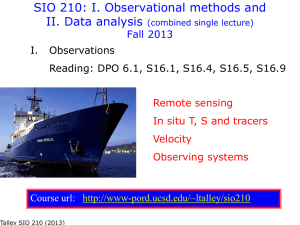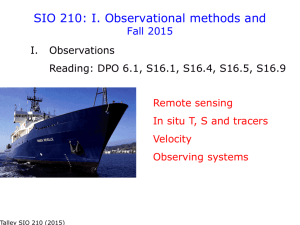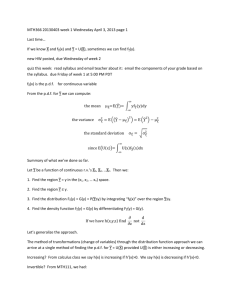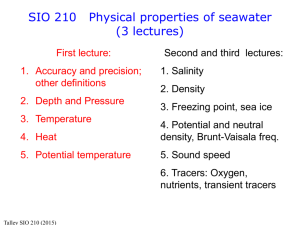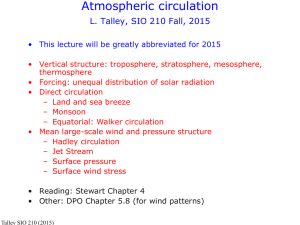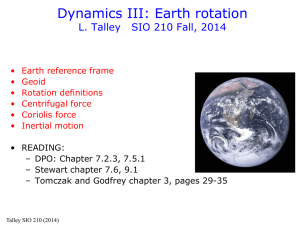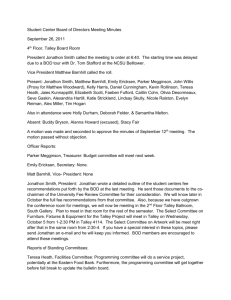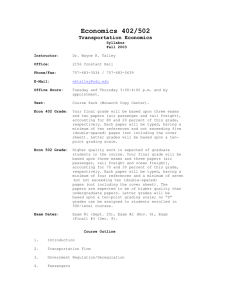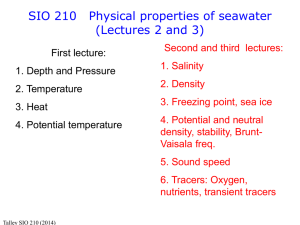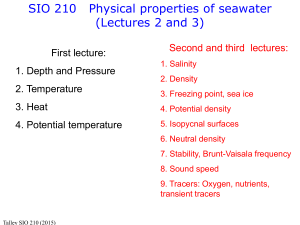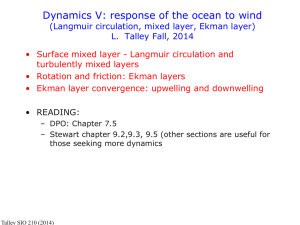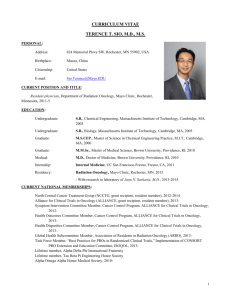powerpoint
advertisement
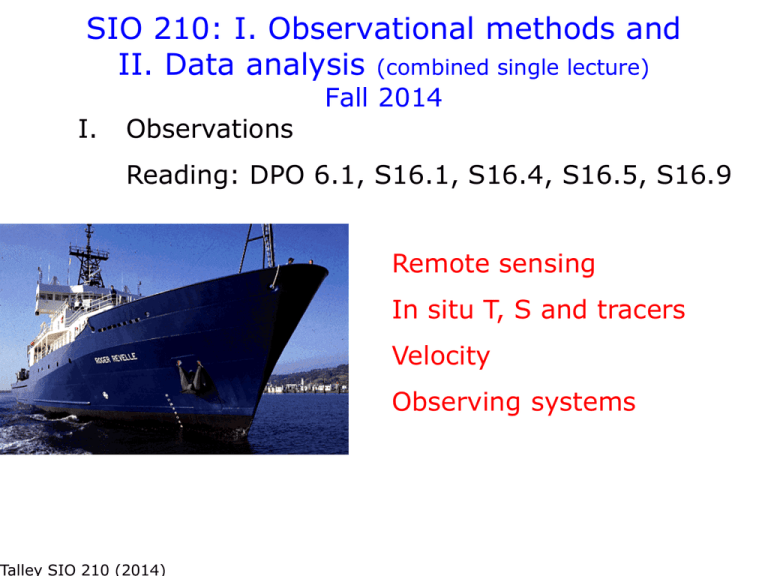
SIO 210: I. Observational methods and II. Data analysis (combined single lecture) Fall 2014 I. Observations Reading: DPO 6.1, S16.1, S16.4, S16.5, S16.9 Remote sensing In situ T, S and tracers Velocity Observing systems Talley SIO 210 (2014) Some definitions • Lagrangian - measurements following the flow. Examples: drifters, floats • Eulerian – measurements at a fixed location. Examples: single profiles, moored instruments, satellites, spatial averages of Lagrangian measurements • Time series - measurements over time, usually at regular intervals, long enough for spectral analysis of frequency content • Synoptic – “snapshot” • Climatology – average over many realizations Talley SIO 210 (2014) Options for ocean observations 1. Remote sensing (satellite) 3a. Research ship 3. ship-based 2. In-situ (in the water) 3b. Merchant ships 4a. Drifting (Lagrangian) 4. autonomous 4b. Fixed (Eulerian) 4c. Steered Talley SIO 210 (2014) 1. Remote sensing (satellites) Sea surface height: Altimetry Rationale: • cm-accuracy sea-surface height •variability from 20-10000km, 20days-10years • heat storage from large-scale steric effect •geostrophic surface flow relative to geoid SST and ocean color Talley SIO 210 (2014) and other quantities (wind, ice, waves, salinity,….) NASA animations: sea surface height http://podaac.jpl.nasa.gov/AnimationsImages/Animations?page=1 Evolution of satellite altimetry Talley SIO 210 (2014) 2. In situ sampling: platforms •Research ships •Merchant ships (VOS = Volunteer Observing Ships) •Surface drifters •Subsurface floats •Fixed moorings •Coastal stations (radar) •Gliders (steered) Talley SIO 210 (2014) 2. In situ sampling: sensors carried on many different platforms •Temperature: thermistors •Salinity: conductivity sensors •Pressure: quartz transducers • (CTD: instrument carrying T, S, P plus ancillary sensors) • (XBT: expendable temperature probe) •Depth: altimeters (sound or EM wave reflection) •Velocity: • current meters (mechanical with compass) • acoustic doppler current meters (sound waves reflecting off particles suspended in the water) • floats and drifters (moving with the water) •Other sensors: • Oxygen, chlorophyll fluorometer, optical properties and radiation sensors Talley SIO 210 (2014) 3a. Ship-based: research ships can reach remote areas, stop, take samples, full depth measurements, handle heavy equipment, but are expensive and slow (the WOCE survey below took 10 years ....). WOCE Experiment Talley SIO 210 (2014) CTD + water sampler rosette 3b. Ship-based: Volunteer Observing Ships (VOS) Commercial ships (ferries, container vessels, etc) which carry out various observations on the way, or deploy probes/instruments Main requirement: - must be able to do this at full speed - should take minimum effort/attendance by crew - modifications to ship should be small Advantages: - Cheap - frequent trans-basin coverages Disadvantages: - startup effort is large - limited sensors - speed - ships may be moved Talley SIO 210 (2014) 3b. VOS: XBT (eXpendable BathyThermograph) temperature probes Hi-resolution XBT network Biases due to manufacturing changes and fall-rate issues are still an active and hot discussion/research topic… Sensor good to 0.05C but fallrate random error can give 0.1-0.2C, and fall-rate biases can be the same (that needs to be resolved) Talley SIO 210 (2014) 4a. Autonomous (Lagrangian) Surface drifters: velocity and a few sensors (SST, SSS, air pressure are common) Talley SIO 210 (2014) 4a. Autonomous (Lagrangian) Subsurface floats: acoustically-tracked Acoustically-tracked: best for continuous tracking (eddy timescales) RAFOS floats (“SOFAR” reversed) Small and cheap, but requires at least 2 sound sources within reach, usually 3-4. Range several 1000km. Floats record the signals and are later located by triangulation. Talley SIO 210 (2014) Stay submerged for entire mission, and surface after 1-3 years, telemetering all data home. Expendable. 4a. Autonomous (Lagrangian) Subsurface floats: “pop-up” (Argo) Profile to 2000 m and tracked every 5 to 10 days, so not eddy resolving. Best for repeat profiling of water column (T,S,other properties) Up to 180 profiles Animation of Argo float profiling Talley SIO 210 (2014) 4b. Autonomous (Eulerian – fixed sensors) Moorings can sample with high rate, from surface to bottom, many simultaneous sensors, and can carry heavy instruments Talley SIO 210 (2014) 4b. Autonomous (Eulerian) Moored current meters (velocity etc) Acoustic Doppler Current Profiler (ADCP) Talley SIO 210 (2014) 4b. Observing system: TAO/Pirata array: tropical ocean - atmosphere Talley SIO 210 (2014) 4b. Autonomous (Eulerian) OceanSITES program – network of moored ocean observatories (bottom and surface moorings) http://www.whoi.edu/virtual/oceansites/index.html Talley SIO 210 (2014) 4b. Sea level: tide gauges (Eulerian) Linear trends in sea level 19932003 (mostly altimetry) Talley SIO 210 (2014) 4c. Steered platforms/sensors: Underwater gliders For long repeat sections or profiling in fixed location – brand new observatories now based on this technology (e.g. California Current) Talley SIO 210 (2014)
